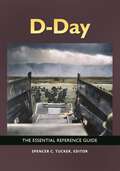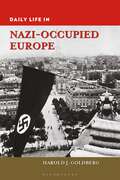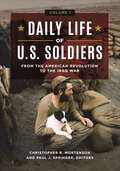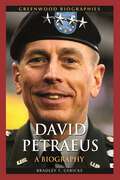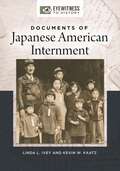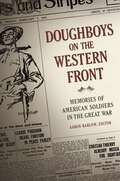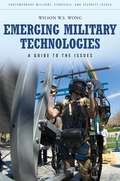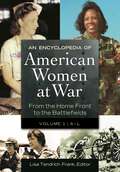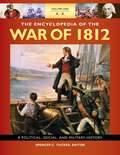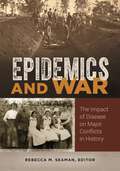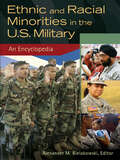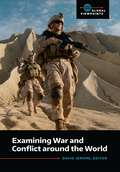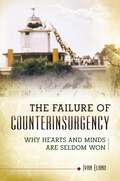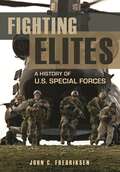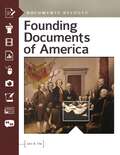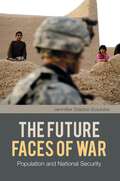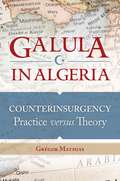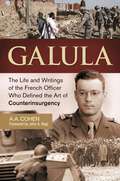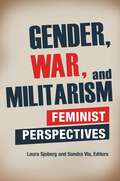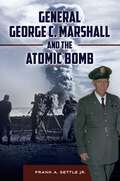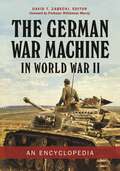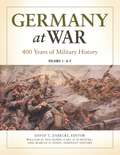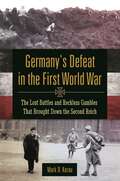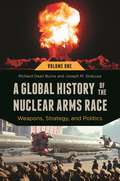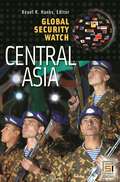- Table View
- List View
D-Day: The Essential Reference Guide
by Spencer C. Tucker, EditorThis outstanding overview of D-Day makes clear its great importance in military and world history, identifies mistakes committed on both sides, and explains all aspects of the 1944 Allied invasion of France and the Normandy Campaign that followed.The beach landings at Normandy, France, in June of 1944 were of critical importance in the outcome of World War II, and as a consequence, served to determine the economic and political state of the modern world as we know it. This latest reference book edited by esteemed historian Spencer C. Tucker supplies easy-to-understand overview entries on the Normandy Invasion ("Operation OVERLORD") and the European Theater in World War II as well as entries treating specific topics such as key individuals, technical innovations, weapons systems, command structures, terrain and logistical difficulties, and the role played by weather.Readers will come to understand why the eventual success of the Allied forces in the D-Day operations was so hard-fought and came at a tremendous cost of life. The book addresses the immense difficulty of supplying tens of thousands of soldiers—many of them inexperienced in combat—and countless tons of equipment and vehicles to the invasion force from over the beaches, after most of the teams landed in the wrong locations, and when many command structures were wiped out almost immediately upon landing; and it explains how these factors impacted the combat on the ground and resulted in the Allied forces' careful planning going awry. The book also describes the elaborate deception carried out by the Allies regarding the invasion landing site and how these efforts impacted battle developments, and it presents nine primary documents that treat various aspects of the battle, including the lengthy Allied plan for the invasion and primary sources of directives regarding the battle and technical innovations.
Daily Life in Nazi-Occupied Europe (The Greenwood Press Daily Life Through History Series)
by Harold J. GoldbergDaily Life in Nazi-Occupied Europe provides readers with information about political and military affairs, economic life, religious life, intellectual life, and other aspects of daily life in those countries occupied by Nazi Germany during World War II.By the end of 1940, the Nazis controlled most of Europe, and in 1941 they invaded the Soviet Union to complete their mission of domination. The pattern of human resistance to the occupation was equally widespread—in every country, at least a significant minority of the population fought for human dignity. Why did so many risk their lives and refuse to accept defeat?This book goes beyond the impact of the occupation on different European countries, examining that impact on individuals who, regardless of what country they lived in, faced a desperate search for food and the constant threat of death. This volume is intended to help readers to see the variety of struggles that contributed to the defeat of the oppressive occupation imposed by the Nazis. Readers will come away with an appreciation of the fact that there were as many types of daily lives as there were individuals under the occupation and that every person in the war had a unique experience.
Daily Life of U.S. Soldiers [3 volumes]: From the American Revolution to the Iraq War [3 volumes]
by Christopher R. Mortenson and Paul J. SpringerThis ground-breaking work explores the lives of average soldiers from the American Revolution through the 21st-century conflicts in Afghanistan and Iraq.What was life really like for U.S. soldiers during America's wars? Were they conscripted or did they volunteer? What did they eat, wear, believe, think, and do for fun? Most important, how did they deal with the rigors of combat and coming home? This comprehensive book will answer all of those questions and much more, with separate chapters on the American Revolution, the War of 1812, the Mexican-American War, the Civil War, the Indian Wars, the Spanish-American War, World War I, World War II in Europe, World War II in the Pacific, the Cold War, the Korean War, the Vietnam War, the Persian Gulf War, the Afghanistan War and War on Terror, and the Iraq War.Each chapter includes such topical sections as Conscription and Volunteers, Training, Religion, Pop Culture, Weaponry, Combat, Special Forces, Prisoners of War, Homefront, and Veteran Issues. This work also examines the role of minorities and women in each conflict as well as delves into the disciplinary problems in the military, including alcoholism, drugs, crimes, and desertion. Selected primary sources, bibliographies, and timelines complement the topical sections of each chapter.
David Petraeus: A Biography (Greenwood Biographies)
by Bradley T. Ph.D.This in-depth and forthright biography examines the personal and professional life of General David Petraeus, today's most prominent military leader.David Petraeus: A Biography offers an objective assessment of the life and career of the man who is arguably the most important military figure of the decade and certainly an officer who has had an enormous impact on U.S. military strategy and policy.The biography examines the full range of Petraeus's experiences, from his youth in New York to his involvement with the 101st Airborne Division to the 2007 MoveOn.org controversy. The author, a military historian and army strategist, explores the general's considerable influence on officer development, as well as the ways in which his integration of diplomatic, economic, and informational components into military campaigns have transformed the Department of Defense's approach to warfare. Readers will be able to clearly trace Petraeus's rise to prominence and discover how his actions have shaped, and been shaped by, current events in the United States and the Middle East.
Documents of Japanese American Internment (Eyewitness to History)
by Linda L. Ivey Kevin W. KaatzExplore Japanese internment through the voices of those who endured removal, those who designed this notorious forced relocation, and those who witnessed the broken promise of U.S. democracy.This document collection sheds light on Japanese American internment through the voices and perspectives of those who directly experienced this event as well as those who created the policy behind it. The book provides readers with a wide range of first-hand accounts, government reports, and media responses that help readers to better understand the events of this unfortunate period of American history.Each document has contextualizing information to help students understand content they may come across in their research. This format is meant to accommodate a wide range of documents that includes a variety of viewpoints and perspectives, such as "eyewitness" pieces (personal narratives, letters; and first-hand accounts); media pieces (newspaper articles, op-ed articles, and reactions and responses to the events); and government and legislative pieces (laws, proclamations, rules, etc.). Books in this series provide a preface, introduction, guide to primary documents, and chronological organization of documents, with each document providing its own introduction, the text of the document or excerpt, and a brief list of additional readings.
Doughboys on the Western Front: Memories of American Soldiers in the Great War
by Aaron BarlowCovering the daily lives of American soldiers from their training through their arrival in France and participation in the final battles of the war, this book offers a breadth of perspectives on the experiences of doughboys in the First World War via primary documents of the time.Due to the mechanical typewriter and the Linotype machine, printed materials during the World War I era were produced quickly and widely distributed. In a time without media other than those on paper, printed materials like newspapers, magazines, books, letters, and army orders were critical for communication. This book examines the range of documents written during World War I or within a few years of the end of the conflict to reveal the experiences of the doughboys who participated in "the war to end all wars." Through documents such as military communications, newspaper accounts, personal letters, divisional histories written soon after the end of hostilities, and other sources, readers get detailed glimpses into the doughboy experience during World War I. The book covers subject matter throughout their time as soldiers, including training in the United States and in France, early participation in conflicts, daily life in the American Expeditionary Force, the major battles for American troops, and what returning home was like for those lucky ones. The assembled narrative of the war experience from many different voices and individuals creates a resource that enables a better understanding the attitudes and perspectives from 1918 through the very early 1920s. Readers will also gain an appreciation of the many changes in American culture that were to follow immediately after the war's conclusion and contribute to the decade of the Roaring Twenties.
Emerging Military Technologies: A Guide to the Issues (Contemporary Military, Strategic, and Security Issues)
by Wilson W.S. WongThis book examines emerging defense technologies such as directed energy weapons, nanotech devices, and bioscience applications that have the potential to dominate international relations in the future, just as nuclear weapons and space infrastructure-assisted conventional weapons do now.Emerging Military Technologies: A Guide to the Issues examines the potential of the United States to bring new technologies to deployment in the service of America's security and defense. The work also discusses how other international actors may regard the United States' investment in these high-tech capabilities, identifying possible resultant counter actions, and presents several divergent viewpoints on what the future may bring.The book thoroughly explores three general categories of emerging technologies: autonomous computers, nanotechnology and biotechnology, and the interrelated topics of directed energy weapons and ubiquitous space access. Security studies expert Wilson W.S. Wong balances coverage of today's cutting-edge science and engineering with treatment of real-world concerns of effectiveness, military ethics, and international relations in the 21st century. An invaluable resource for members of the military and intelligence communities, this book also provides general readers with an accessible introduction to these highly technical topics.
An Encyclopedia of American Women at War [2 volumes]: From the Home Front to the Battlefields [2 volumes]
by Lisa Tendrich FrankA sweeping review of the role of women within the American military from the colonial period to the present day.In America, the achievements, defeats, and glory of war are traditionally ascribed to men. Women, however, have been an integral part of our country's military history from the very beginning. This unprecedented encyclopedia explores the accomplishments and actions of the "fairer sex" in the various conflicts in which the United States has fought.An Encyclopedia of American Women at War: From the Home Front to the Battlefields contains entries on all of the major themes, organizations, wars, and biographies related to the history of women and the American military. The book traces the evolution of their roles—as leaders, spies, soldiers, and nurses—and illustrates women's participation in actions on the ground as well as in making the key decisions of developing conflicts. From the colonial conflicts with European powers to the current War on Terror, coverage is comprehensive, with material organized in an easy-to-use, A–Z, ready-reference format.
The Encyclopedia of the War of 1812 [3 volumes]: A Political, Social, and Military History [3 volumes]
by Dr Spencer C. TuckerThis work is the most comprehensive reference work on the War of 1812 yet published, offering a multidisciplinary treatment of course, causes, effects, and specific details of the War that provides both quick reference and in-depth analysis for readers from the high school level to scholars in the field.The Encyclopedia of the War of 1812: A Political, Social, and Military History dedicates 872 entries—totaling some 600,000 words—to this important American war. It is the most comprehensive and significant reference work available on the subject. Its entries spotlight the key battles, standout individuals, essential weapons, and social, political, and economic developments, and examine the wider, concurrent European developments which directly affected this conflict in North America. A volume of primary documents provides more avenues for research.This three-volume work offers comprehensive, in-depth information in a format that lends itself to quick and easy use, making it ideal for high school, college, and university-level learners as well as general learning annexes and military libraries. Scholars of the period and students of American military history will find it essential reading.
Epidemics and War: The Impact of Disease on Major Conflicts in History
by Rebecca M. SeamanThrough its coverage of 19 epidemics associated with a broad range of wars, and blending medical knowledge, demographics, geographic, and medical information with historical and military insights, this book reveals the complex relationship between epidemics and wars throughout history.How did small pox have a tremendous effect on two distinct periods of war—one in which the disease devastated entire native armies and leadership, and the other in which technological advancements and the application of medical knowledge concerning the disease preserved an army and as a result changed the course of events? Epidemics and War: The Impact of Disease on Major Conflicts in History examines fascinating historical questions like this and dozens more, exploring a plethora of communicable diseases—viral, fungal, and/or bacterial in nature—that spread and impacted wars or were spread by some aspect of mass human conflict.Written by historians, medical doctors, and people with military backgrounds, the book presents a variety of viewpoints and research approaches. Each chapter examines an epidemic in relation to a period of war, demonstrating how the two impacted each other and affected the populations involved directly and indirectly. Starting with three still unknown/unidentified epidemics (ranging from Classical Athens to the Battle of Bosworth in England), the book's chapters explore a plethora of diseases that spread through wars or significantly impacted wars. The book also examines how long-ended wars can play a role in the spread of epidemics a generation later, as seen in the 21st-century mumps epidemic in Bosnia, 15 to 20 years after the Bosnian conflicts of the 1990s.
Ethnic and Racial Minorities in the U.S. Military [2 volumes]: An Encyclopedia [2 volumes]
by Alexander M. BielakowskiThis encyclopedia details the participation of individual ethnic and racial minority groups throughout U.S. military history.Ethnic and Racial Minorities in the U.S. Military: An Encyclopedia is unique in its coverage of nearly all major ethnic and racial minority groups, as opposed to reference works that have focused only on individual ethnic or racial minority groups. It acknowledges the military contributions of African Americans, Asian Americans, French Americans, German Americans, Hispanic Americans, Irish Americans, Jewish Americans, and Native Americans. This timely work highlights the individuals and events that have shaped the experience of minorities in U.S. conflicts. The work provides a comprehensive encyclopedia covering the role of all major ethnic and racial minorities in the United States during wartime. Additionally, it considers how the integration of servicemen in the U.S. military set the precedent for the eventual desegregation of America's civilian population.
Examining War and Conflict around the World (Global Viewpoints)
by David JeromeThis volume addresses 10 issues pertaining to war and conflict, such as ethics of war, national security, and refugees, and examines how countries around the world are facing these issues.To truly explore war and conflict, one must consider why the peoples and the leaders of the world behave the way that they do toward one another. For instance, why are refugees, in a variety of circumstances, treated so inhumanely in times of conflict and unrest through no fault of their own? How are women and those in the LGBTQ community treated in terms of service to their country? Examining War and Conflict around World includes ten chapters, each addressing a specific issue relating to war and conflict as it pertains to a variety of countries, including anti-Americanism, military robots and drones, nuclear weapons and proliferation, and torture. Each chapter begins with an introduction to the issue. Following the chapter introduction, each chapter highlights that issue in eight countries. Chapters provide historical perspective, but the book addresses each of the issues in a contemporary context. This work will provide an overview for all readers of ten very important topics that address matters relating to war and conflict in the twenty-first century.
The Failure of Counterinsurgency: Why Hearts and Minds Are Seldom Won (Praeger Security International)
by Ivan ElandThis book examines the implications of counterinsurgency warfare for U.S. defense policy and makes the compelling argument that the United States' default position on counterinsurgency wars should be to avoid them.Given the unsatisfactory outcomes of the counterinsurgency (COIN) wars in Afghanistan and Iraq, the U.S. military is now in a heated debate over whether wars involving COIN operations are worth fighting. This book provides a comprehensive analysis of the effectiveness of COIN through key historic episodes and concludes that the answer is an emphatic "no," based on a dominant record of U.S. military or political failure, and inconsistency in the reasons for the rare cases of success. The author also examines the implications of his findings for U.S. foreign policy, defense policy, and future weapons procurement.
Fighting Elites: A History of U.S. Special Forces
by John C. FredriksenFrom Army Rangers to Green Berets to the U.S. Navy SEAL team that killed Osama bin Laden, this book explains what makes Special Forces "special," covering the rich and varied history of elite formations in American military history and describing their recruitment, intense training, and equipment in depth.Most civilians have only a vague idea of what the U.S. Special Forces are all about—who they are, how they differ from our "normal" military forces, what they've accomplished throughout our history, and how they operate today. Fighting Elites: A History of U.S. Special Forces examines the rich and varied history of U.S. Special Forces, identifies their contributions to specific conflicts from colonial times forward, and highlights their present operational excellence.In this first-ever reference guide to U.S. Special Forces, military historian John C. Fredriksen provides a carefully balanced presentation, describing all units in their own detailed section that discusses their origins, recruitment, training, tactics, and equipment, and defining military engagements, if known. The text also contains 20 biographical entries of noted personalities associated with special purpose activities.
Founding Documents of America: Documents Decoded (Documents Decoded)
by John R. VileWritten by a renowned expert on the American Founding period, this book examines selections of key documents from 1215 through 1791 that were instrumental to the development of the U.S. Constitution and the American political tradition.The latest addition to ABC-CLIO's popular Documents Decoded series, John R. Vile's Founding Documents of America presents historic documents key to the foundations of our nation's government accompanied by introductions that supply background information and analysis that highlights key provisions and provide historical context. The coverage extends beyond the Declaration of Independence, the Constitution, and the Bill of Rights to provide contextual understanding of a wide range of other documents, such as private diary entries and political polemics, that will further readers' understanding of the United States' founding and early political development.The documents are organized chronologically into four sections: constitutional antecedents; the revolutionary and confederal periods; calling and convening the Constitutional Convention; and debating, ratifying, implementing, and amending the new Constitution. Through its more than 50 primary source documents—from the Magna Carta of 1215 through the Bill of Rights, which was adopted in 1791—this book will serve high school and college students seeking to understand the documents that laid the foundations for the U.S. Constitution and Bill of Rights, and provide opportunities for student readers to build critical thinking skills.
The Future Faces of War: Population and National Security (The Changing Face of War)
by Jennifer Dabbs SciubbaThis comprehensive and clear volume reveals the numerous ways demographic trends such as age structure, composition, and migration influence national security.Population size, structure, distribution, and composition affect security in numerous ways, including national power, civil conflict, and development. The Future Faces of War: Population and National Security offers a comprehensive overview of how demographic trends can function as components, indicators, and multipliers of a state's national security. Each chapter focuses on a particular demographic trend and describes its national security implications in three realms—military, regime, and structural.Illustrating the mechanisms by which demography and security are connected, the book pushes the conversation forward by challenging common conceptions about demographic trends and national security. Key for policymakers and general readers alike, it goes on to suggest ways trends can provide opportunities for building partnerships and strengthening states. Focusing on multiple scenarios and the theoretical links between population and security, the insights gathered here will remain relevant for years to come.
Galula in Algeria: Counterinsurgency Practice versus Theory (Praeger Security International)
by Grégor MathiasThis groundbreaking investigation uncovers serious mismatches between David Galula's counterinsurgency practice in Algeria and his counterinsurgency theory—the foundation of current U.S. counterinsurgency doctrine in Iraq and Afghanistan.Given the centrality of David Galula's theory to U.S. Counterinsurgency (COIN) doctrine in Iraq and Afghanistan, it is striking that there has been no independent evaluation of Galula's recollection of his COIN operations in Algeria. Galula in Algeria: Counterinsurgency Practice versus Theory delivers just such an analysis, exploring the colonial French counter-insurrectionary theoretical milieu of which Galula's COIN theory was a part, the influence of Galula's theory on U.S. COIN doctrine, and the current views of Galula's theory in France and other NATO countries. French defense researcher Grégor Mathias compares each of the eight steps of Galula's theory set out in Counterinsurgency Warfare against his practice of them as described in his writings and now, for the first time, against the SAS archives and those of Galula's infantry company and battalion. The study shows that Galula systematically inflated his operational successes to match his theoretical scheme and that he left problems unresolved, causing his work to unravel quickly after he left his command. Mathias concludes that, however heuristically fruitful Galula's theory might prove for U.S. COIN doctrine, it must be interpreted and implemented under the caveat that it was not successfully field-tested by its author..
Galula: The Life and Writings of the French Officer Who Defined the Art of Counterinsurgency
by A A. CohenThis comprehensive analytical biography is the definitive work on the life and writings of history's most significant counterinsurgency doctrinaire, David Galula, elucidating the context for his reflections and examining the present and future applicability of his treatise for scholars and practitioners alike.The product of years of extensive research made possible by exclusive access to Galula's personal papers as well as first-hand accounts from colleagues, family members, and friends, this book traces Galula's life from early childhood until death, describing his upbringing, education, and military career in the tumultuous historical context of his era. The author—a former counterinsurgency practitioner himself—pays particular attention to how the Chinese Revolution and the Algerian War affected Galula's views, and identifies Galula's mentors and the schools of thought within the French military that greatly influenced his writings. A conclusion illuminates the contemporary and likely future validity of his works. In the epilogue, the author speaks to Galula's influence over modern military thought and U.S. counterinsurgency doctrine. This book is essential reading for individuals with an interest in counterinsurgency, Galula's writings, or Galula himself, such as military officers and civilian administrators undertaking counterinsurgency courses and training.
Gender, War, and Militarism: Feminist Perspectives (Praeger Security International)
by Laura Sjoberg Sandra ViaThis compelling, interdisciplinary compilation of essays documents the extensive, intersubjective relationships between gender, war, and militarism in 21st-century global politics.Feminist scholars have long contended that war and militarism are fundamentally gendered. Gender, War, and Militarism: Feminist Perspectives provides empirical evidence, theoretical innovation, and interdisciplinary conversation on the topic, while explicitly—and uniquely—considering the links between gender, war, and militarism. Essentially an interdisciplinary conversation between scholars studying gender in political science, anthropology, and sociology, the essays here all turn their attention to the same questions. How are war and militarism gendered?Seventeen innovative explanations of different intersections of the gendering of global politics and global conflict examine the theoretical relationship between gender, militarization, and security; the deployment of gender and sexuality in times of conflict; sexual violence in war and conflict; post-conflict reconstruction; and gender and militarism in media and literary accounts of war. Together, these essays make a coherent argument that reveals that, although it takes different forms, gendering is a constant feature of 21st-century militarism.
General George C. Marshall and the Atomic Bomb
by Frank A. Jr.This book details the evolution of General George Marshall's relationship with the atomic bomb—including the Manhattan Project and the use of atomic weapons on Japan—as it emerged as the ultimate weapon of mass destruction.The atomic bomb is not only the most powerful weapon ever used in the history of warfare: it is also the most significant in terms of its long-term impact on U.S. military power and policy, and as the reason behind the conflict that raged for four decades without actually happening—the Cold War. General George C. Marshall played an instrumental role in the development and use of the atomic bomb in World War II as well as in issues involving nuclear weapons in the post-World War II period. This book tells the story of Marshall's experience with the atomic bomb from his early skepticism of its effectiveness as a weapon, to his oversight of its development and deployment against Japan in World War II, to his recognition of the bomb as a weapon of such dire consequence that it should never be used again.Intended for a general audience as well as scholars with specific knowledge about the subject matter, this book presents a cohesive account of General Marshall's involvement with nuclear weapons and atomic power as Army chief of staff during World War II and as secretary of state and secretary of defense in the early years of the Cold War. Marshall's involvement with the use of nuclear weapons is set in the context of the Allies' efforts to force Japan to surrender and the initiation of the Cold War. Readers will gain insight into Marshall's quest for obtaining a Japanese surrender; his views on the use of the atomic bomb on Japan versus the use of conventional weapons, including fire bombing or poison gas; his interactions with Roosevelt and Truman on nuclear issues; and Marshall's diplomatic skillfulness in dealing with the issues surrounding the control and use of nuclear weapons as secretary of state and secretary of defense in the post-World War II era. These included consideration of the use of the atomic bomb during the Berlin crisis and the Korean war.
The German War Machine in World War II: An Encyclopedia
by David T. ZabeckiThis invaluable resource offers students a comprehensive overview of the German war machine that overran much of Europe during World War II, with close to 300 entries on a variety of topics and a number of key primary source documents.This book provides everything the reader needs to know about the German war machine that developed into the potent armed force under Adolf Hitler. This expansive encyclopedia covers the period of the German Third Reich, from January 1933 to the end of World War II in Europe, in May 1945. Dozens of entries on key battles and military campaigns, military and political leaders, military and intelligence organizations, and social and political topics that shaped German military conduct during World War II are followed by an illuminating epilogue that outlines why Germany lost World War II.A documents section includes more than a dozen fascinating primary sources on such significant events as the Tripartite Pact among Germany, Italy, and Japan; the Battle of Stalingrad; the Normandy Invasion; the Ardennes Offensive; and Germany's surrender. In addition, six appendices provide detailed information on a variety of topics such as German aces, military commanders, and military medals and decorations. The book ends with a chronology and a bibliography of print resources.
Germany at War [4 volumes]: 400 Years of Military History [4 volumes]
by David T. Zabecki William H. Van Husen Carl O. Schuster Marcus O. JonesWritten by experts for use by nonexperts, this monumental work probes Germany's "Genius for War" and the unmistakable pattern of tactical and operational innovation and excellence evident throughout the nation's military history.Despite having the best military forces in the world, some of the most advanced weapons available, and unparalleled tactical proficiency, Germany still lost both World Wars. This landmark, four-volume encyclopedia explores how and why that happened, at the same time examining Germany as a military power from the start of the Thirty Years' War in 1618 to the present day. Coverage includes the Federal Republic of Germany, its predecessor states, and the kingdoms and principalities that combined to form Imperial Germany in 1871.The Seven Years' War is discussed, as are the Napoleonic Wars, the Wars of German Unification (including the Franco-Prussian War), World War I, World War II, and the Cold War. In all, more than 1,000 entries illuminate battles, organizations, leaders, armies, weapons, and other aspects of war and military life. The most comprehensive overview of German military history ever to appear in English, this work will enable students and others interested in military history to better understand the sociopolitical history of Germany, the complex role conflict has played in the nation throughout its history, and why Germany continues to be an important player on the European continent.
Germany's Defeat in the First World War: The Lost Battles and Reckless Gambles That Brought Down the Second Reich
by Mark D. KarauA noted World War I scholar examines the critical decisions and events that led to Germany's defeat, arguing that the German loss was caused by collapse at home as well as on the front.Much has been written about the causes for the outbreak of World War I and the ways in which the war was fought, but few historians have tackled the reasons why the Germans, who appeared on the surface to be winning for most of the war, ultimately lost. This book, in contrast, presents an in-depth examination of the complex interplay of factors—social, cultural, military, economic, and diplomatic—that led to Germany's defeat.The highly readable work begins with an examination of the strengths and weaknesses of the two coalitions and points out how the balance of forces was clearly on the side of the Entente in a long and drawn-out war. The work then probes the German plan to win the war quickly and the resulting campaigns of August and September 1914 that culminated in the devastating defeat in the First Battle of the Marne. Subsequent chapters discuss the critical factors and decisions that led to Germany's loss, including the British naval blockade, the role of economic factors in maintaining a consensus for war, and the social impact of material deprivation.
A Global History of the Nuclear Arms Race [2 volumes]: Weapons, Strategy, and Politics [2 volumes] (Praeger Security International)
by Richard Dean Burns Joseph M. SiracusaWritten by two preeminent authors in the field, this book provides an accessible global narrative of the nuclear arms race since 1945 that focuses on the roles of key scientists, military chiefs, and political leaders.The first book of its kind to provide a global perspective of the arms race, this two-volume work connects episodes worldwide involving nuclear weapons in a comprehensive, narrative fashion. Beginning with a discussion of the scientific research of the 1930s and 1940s and the Hiroshima decision, the authors focus on five basic themes: political dimensions, technological developments, military and diplomatic strategies, and impact.The history of the international nuclear arms race is examined within the context of four historical eras: America's nuclear monopoly, America's nuclear superiority, superpower parity, and the post-Cold War era. Information about the historical development of the independent deterrence of Britain, France, and China, as well as the piecemeal deterrence of newcomers Israel, India, Pakistan, and North Korea is also included, as is coverage of the efforts aimed at the international control of nuclear weapons and the diplomatic architecture that underpins the global nuclear non-proliferation regime.
Global Security Watch—Central Asia (Global Security Watch)
by Reuel R. HanksThis volume is the only current treatment of security issues in Central Asia for the nonspecialist, as well as specialists and policy-makers.Global Security Watch—Central Asia is the first authoritative examination of the security issues affecting, and affected by, the region where Russia, South Asia, China, and the Middle East meet. The author provides a comprehensive account of the strategic importance and challenges facing Central Asia written for policymakers, students, researchers, and interested general readers alike.Global Security Watch—Central Asia goes behind the scenes to explore both the internal factors and global influences affecting the stability of region and the nations that comprise it. Coverage includes the dynamics of each country's domestic politics, the allure of the region's natural resources, Central Asia's role in U.S./Russian relations, and the renewed focus on the region in the aftermath of the attacks of September 11, 2001.
